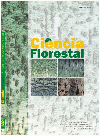
|
Ciência Florestal
Centro de Pesquisas Florestais - CEPEF, Departamento de Ciências Florestais - DCFL, Programa de Pós Graduação em Engenharia Florestal - PPGEF
ISSN: 0103-9954
EISSN: 0103-9954
Vol. 28, No. 2, 2018, pp. 715-724
|
 Bioline Code: cf18066
Bioline Code: cf18066
Full paper language: Portuguese
Document type: Research Article
Document available free of charge
|
|
|
Ciência Florestal, Vol. 28, No. 2, 2018, pp. 715-724
| pt |
PROGNOSE DA DISTRIBUIÇÃO DIAMÉTRICA POR MATRIZ DE TRANSIÇÃO EM FLORESTA APÓS COLHEITA NO LESTE DA AMAZÔNIA
Reis, Leonardo Pequeno; Torres, Carlos Moreira Miquelino Eleto; Souza, Agostinho Lopes de; Freitas, Lucas José Mazzei de; Reis, Pamella Carolline Marques dos Reis; Silva, Liniker Fernandes da & Leite, Rodrigo Vieira
Resumo
No manejo florestal é importante projetar a distribuição diamétrica ao longo do ciclo de corte para subsidiar
as técnicas silviculturais mais adequadas à estrutura da floresta. O objetivo do trabalho foi projetar a
distribuição diamétrica ao longo do ciclo de corte utilizando Matriz de Transição Markoviana. Em 1979 foi
realizada a colheita seletiva, com intensidade de 72,5 m3 ha-1, em uma área de 64 ha, na Floresta Nacional
do Tapajós, Pará. Em 1981 foram instaladas, aleatoriamente, 36 parcelas permanentes de 50 m x 50 m
medidas sucessivamente em 1982, 1983, 1985, 1987, 1992, 1997, 2007, 2010 e 2012. Para a projeção foram
usadas duas matrizes de transição: uma com intervalo de tempo de um ano (1981 a 1982) e outra de dois
anos (1981 a 1983). Todas as projeções apresentaram distribuição diamétrica em forma de “J” invertido,
com pequena descontinuidade no último ano (2012). Houve aderência da distribuição diamétrica a 5% de
significância entre os dados observados e estimados até aos 11 anos de projeção. A matriz de transição pode
ser usada para projetar a distribuição diamétrica após a colheita em pequenos períodos de tempo após a
colheita florestal.
Palavras-chave
manejo florestal; modelo de crescimento e produção; cadeia de Markov
|
| |
| en |
PROGNOSIS OF DIAMETRIC DISTRIBUTION BY TRANSITION MATRIX AFTER HARVEST IN A FOREST IN EASTERN AMAZON
Reis, Leonardo Pequeno; Torres, Carlos Moreira Miquelino Eleto; Souza, Agostinho Lopes de; Freitas, Lucas José Mazzei de; Reis, Pamella Carolline Marques dos Reis; Silva, Liniker Fernandes da & Leite, Rodrigo Vieira
Abstract
In forest management, it is important to project diametric distribution along the cutting cycle to subsidize
the most suitable silvicultural techniques to forest structure. The aim of this work was to project diametric
distribution along the cutting cycle using Markov Transition Matrix. In 1979, selective harvest was
performed with an intensity of 72.5 m3 ha-1, in a 64 ha area in ‘Floresta Nacional do Tapajós’ – Pará state
(PA). In 1981, 36 permanent plots of 50m x 50m were randomly installed and measured successively in
1982, 1983, 1985, 1987, 1992, 1997, 2007, 2010 and 2012. For the projection, two transition matrices
were used: one with time interval of one year (1981 to 1982) and another of two years (1981 to 1983). All
projections showed diametric distribution in inverted “J” form, with small discontinuity last year (2012).
There was adherence of diametric distribution at 5% significance between observed and estimated data,
up to 11 years of projection. Transition matrix can be used to project diametric distribution after harvest
in short periods of time after the forest harvest.
Keywords
forest management; diametric distribution model; Markov chain
|
| |
© Copyright [2018] - Ciência Florestal
Alternative site location: http://cascavel.ufsm.br/revistas/ojs-2.2.2/index.php/cienciaflorestal/index
|
|
